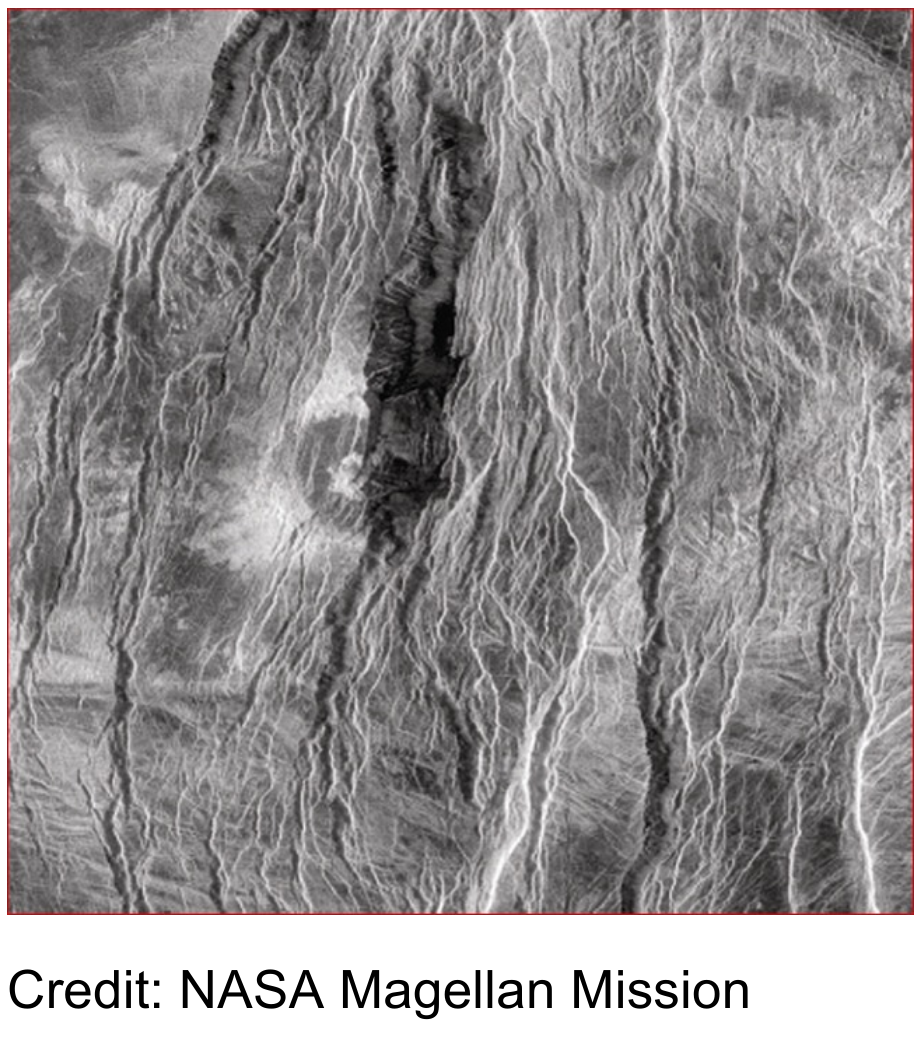[Venus the Bright Planet 金星という明るい惑星]

――――――――
Jul 19, 2007
金星はその深い雲層の上部からの光を反射しますが、宇宙探査機のデータは、表面も高度に反射していることを示しています。
金星は、今、数ヶ月の間、夕方の星です。
薄明かりの空の中でその場所から離れ始め、おなじみの夜明けの仲間、朝の星としての地位を占めるようになると、私たちのいわゆる「姉妹惑星」についてのいくつかの興味深い事実と不可解な質問は、検討に値します。
ページ上部の画像は、1991年9月にマゼラン宇宙船によって金星から送られたものです。
〈https://nssdc.gsfc.nasa.gov/planetary/factsheet.html〉
マゼランは、1994年10月12日に接触が失われるまで、4年間極軌道で金星を周回しました。
その主な使命は、搭載された合成開口レーダー画像システムを使用して、惑星の奇妙な地形の高解像度ビデオを撮影することでした。
バルチャー・クレーター(上の画像の中央)は、直径約35キロメートルです。
他のクレーターに見られるものと同様に、隆起した中央の地層が、ある種の激しい地殻変動力によって半分にカットされているので、それはユニークです。
〈https://www.lpi.usra.edu/venus/craters/images/65.9n007.0p225.gif〉
2005年11月9日、欧州宇宙機関はカザフスタンのバイコヌール宇宙基地からビーナスエクスプレスミッションを開始しました。
〈https://www.esa.int/Science_Exploration/Space_Science/Venus_Express/Watch_the_Venus_Express_launch〉
〈https://www.esa.int/Science_Exploration/Space_Science/Venus_Express/Venus_Express_factsheet2〉
宇宙船は、太陽系の2番目の惑星に関する他の興味深い質問に答えるのに役立つよう設計されました:
〈https://www.esa.int/Science_Exploration/Space_Science/Venus_Express/Venus_Express_objectives〉
1. 表面の一部の領域がレーダーに対して非常に反射するのはなぜですか?
2. 現在、地球上に火山活動や地震活動がありますか?
3. 惑星の複雑なグローバル(全球的)ダイナミクスはどのように機能しますか?
4. 超高速の大気回転とハリケーンの強風の原因は何ですか?
5. 極で二重大気渦を維持するものは何ですか?
マゼランミッションによって収集された情報と相まって、ESAプログラムは、惑星科学者達に、今後数年間、金星の異常な環境を熟考するのに十分なデータを提供する筈です。
しかしながら、ミッションの科学者達は、金星の電気環境が地質学的プロセスや私たちが目にする奇妙な地形にどのように影響するかを知らないため、直面している複雑な問題について完全な説明を提供することはできません。
過去のThunderbolts 「今日の写真」では、これらの問題のいくつかを調査してきました。
〈https://takaakifukatsu.hatenablog.jp/entry/2021/08/04/064333〉
金星の山の多くには、レーダーで非常に明るく輝く山があります。
奇妙な明るさの理由はNASAの謎ですが、電気的宇宙の観点からは、山頂は「聖、エルモの火。」で輝いて居ます。
〈https://takaakifukatsu.hatenablog.jp/entry/2021/08/06/151710〉
セントエルモの火は静電気に似たプラズマ現象であり、帯電したプラズマはレーダーを鏡のように反射します。
したがって、山の高いアルベドは、その放電の結果である可能性があります。
地球の広大な地域は「新星」によって切り取られています、
または、深い溝の外側に伸びる―
放射状の―
平行破壊の領域から。
〈https://sciences.univ-amu.fr/fr/departements/informatique-interactions〉
〈https://photojournal.jpl.nasa.gov/jpeg/PIA00469.jpg〉
NASAとESAの両方のアナリストは、これらの地層を火山湧昇の残骸として特定しました。
過去のある時期に、地下のマグマが部分的に溶けて表面を膨らませました。
しばらくすると、マグマは沈静化し、表面は冷えて収縮し、割れ目のネットワークが残りました。
しかしながら、私達が、過去に指摘したように、これらの特徴は、リッチェンバーグ(リヒテンベルク)図形と呼ばれる稲妻の傷跡に非常によく似ています。
〈https://takaakifukatsu.hatenablog.jp/entry/2021/04/23/211110〉
〈https://photojournal.jpl.nasa.gov/jpeg/PIA00150.jpg〉
〈https://takaakifukatsu.hatenablog.jp/entry/2021/06/18/184602〉
「コロナ(ェ)」と呼ばれる他の複雑な構造は、「新星」の縞模様のように、放射状の亀裂を切り裂く尾根と谷の輪を特徴とする楕円形の層です。
〈https://photojournal.jpl.nasa.gov/jpeg/PIA00461.jpg〉
〈https://photojournal.jpl.nasa.gov/jpeg/PIA00101.jpg〉
コロナ(ェ)は、いわゆる「パンケーキ火山」に関連してよく見られます―
数百平方キロメートルをカバーする広くて平らなドームです。
〈https://photojournal.jpl.nasa.gov/jpeg/PIA00215.jpg〉
電気的理論家達は、巨大なプラズマ放電の結果として、「楯状火山」や「ペデスタル(台座)・クレーター」も含むそのような構造を説明しています。
このような電気力は、周囲の領域を通るクレーターとチャネルを切り開くときに、物質を渦の中心に向かって引き寄せます。
電気アークが通過した後、多くの場合それを取り囲む堀を伴う、隆起した破片の山が残されます。
火星のオリンパス山や金星のエイストラ地域など、隆起した塚のいくつかは非常に大きくなる可能性があります。
〈https://takaakifukatsu.hatenablog.jp/entry/2021/07/02/214449〉
〈https://photojournal.jpl.nasa.gov/jpegMod/PIA00084_modest.jpg〉
金星がどのように形成され、その表面がどのように爆破されて摩耗したかについての理論には、さまざまな状況で電気がどのように振る舞うかを含める必要があります。
金星の高密度大気では、電気アークは太陽系の他の場所で見られるものと同様の地形を切り開きますが、それは独特の属性を持っています。
たとえば、非常にエネルギーの高い放電は、火星に見られる「クモ(の巣)」に似ているが、はるかに大きく、より顕著である「アラクノイド」と呼ばれる渦巻く構造と同様に、深く定着した地層を残します。
〈https://nssdc.gsfc.nasa.gov/imgcat/hires/mgn_c115s095_1.gif〉
〈https://takaakifukatsu.hatenablog.jp/entry/2021/08/29/215415〉
私たちが探索したすべての惑星と月衛星がおそらく最近の壊滅的な出来事によって特徴づけられていることを理解することは、それらがそのような従来の奇妙な形態を示す理由のより適切な理解に向けて私たちの研究を導くでしょう。
スティーブン・スミス
――――――――
Jul 19, 2007
Venus reflects light from the top of its deep cloud layer, but space probe data indicates that the surface is also highly reflective.
金星はその深い雲層の上部からの光を反射しますが、宇宙探査機のデータは、表面も高度に反射していることを示しています。
Venus has been the evening star for several months, now.
金星は、今、数ヶ月の間、夕方の星です。
As it begins to move away from its place in twilight skies and take up a position as a familiar dawn companion, the morning star, some interesting facts and puzzling questions about our so-called “sister planet” are worthy of consideration.
薄明かりの空の中でその場所から離れ始め、おなじみの夜明けの仲間、朝の星としての地位を占めるようになると、私たちのいわゆる「姉妹惑星」についてのいくつかの興味深い事実と不可解な質問は、検討に値します。
The image at the top of the page was sent from Venus by the Magellan spacecraft in September of 1991.
ページ上部の画像は、1991年9月にマゼラン宇宙船によって金星から送られたものです。
〈https://nssdc.gsfc.nasa.gov/planetary/factsheet.html〉
Magellan circled Venus in a polar orbit for four years until contact was lost on October 12, 1994.
マゼランは、1994年10月12日に接触が失われるまで、4年間極軌道で金星を周回しました。
Its primary mission was to use an onboard synthetic aperture radar imaging system and shoot high resolution video of the planet’s strange topography.
その主な使命は、搭載された合成開口レーダー画像システムを使用して、惑星の奇妙な地形の高解像度ビデオを撮影することでした。
Balcher crater (center of above image), is approximately 35 kilometers in diameter.
バルチャー・クレーター(上の画像の中央)は、直径約35キロメートルです。
It’s unique because the raised central formation, similar to those found in other craters, has been cut in half by some kind of violent tectonic force.
他のクレーターに見られるものと同様に、隆起した中央の地層が、ある種の激しい地殻変動力によって半分にカットされているので、それはユニークです。
〈https://www.lpi.usra.edu/venus/craters/images/65.9n007.0p225.gif〉
On November 9, 2005, The European Space Agency launched the Venus Express mission from Baikonur Cosmodrome, Kazakhstan.
2005年11月9日、欧州宇宙機関はカザフスタンのバイコヌール宇宙基地からビーナスエクスプレスミッションを開始しました。
〈https://www.esa.int/Science_Exploration/Space_Science/Venus_Express/Watch_the_Venus_Express_launch〉
〈https://www.esa.int/Science_Exploration/Space_Science/Venus_Express/Venus_Express_factsheet2〉
The spacecraft was designed to help answer other intriguing questions about the solar system’s second planet:
宇宙船は、太陽系の2番目の惑星に関する他の興味深い質問に答えるのに役立つよう設計されました:
〈https://www.esa.int/Science_Exploration/Space_Science/Venus_Express/Venus_Express_objectives〉
2. Why are some areas on the surface so reflective to radar?
表面の一部の領域がレーダーに対して非常に反射するのはなぜですか?
2. Is there presently volcanic or seismic activity on the planet?
現在、地球上に火山活動や地震活動がありますか?
3. How do the complex global dynamics of the planet work?
惑星の複雑なグローバル(全球的)ダイナミクスはどのように機能しますか?
4. What causes the super-fast atmospheric rotation and the hurricane-force winds?
超高速の大気回転とハリケーンの強風の原因は何ですか?
5. What maintains the double atmospheric vortex at the poles?
極で二重大気渦を維持するものは何ですか?
Coupled with information collected by the Magellan Mission, the ESA program should provide planetary scientists with enough data to ponder the unusual environment of Venus for years to come.
マゼランミッションによって収集された情報と相まって、ESAプログラムは、惑星科学者達に、今後数年間、金星の異常な環境を熟考するのに十分なデータを提供する筈です。
However, because mission scientists are unaware of how the electrical environment of Venus influences the geologic processes and the bizarre terrain that we see, they are not able to provide complete explanations for the complex issues that face them.
しかしながら、ミッションの科学者達は、金星の電気環境が地質学的プロセスや私たちが目にする奇妙な地形にどのように影響するかを知らないため、直面している複雑な問題について完全な説明を提供することはできません。
In past Thunderbolts Pictures of the Day, we have explored some of those issues.
過去のThunderbolts 「今日の写真」では、これらの問題のいくつかを調査してきました。
〈https://takaakifukatsu.hatenablog.jp/entry/2021/08/04/064333〉
Many of the mountains on Venus have peaks that shine very brightly in radar.
金星の山の多くには、レーダーで非常に明るく輝く山があります。
Although the reason for the strange brightness is a mystery for NASA, from an electric universe standpoint, the mountain peaks are glowing with a form of “St. Elmo’s Fire.”
奇妙な明るさの理由はNASAの謎ですが、電気的宇宙の観点からは、山頂は「聖、エルモの火。」で輝いて居ます。
〈https://takaakifukatsu.hatenablog.jp/entry/2021/08/06/151710〉
St. Elmo’s Fire is a plasma phenomenon, similar to static electricity, and charged plasma reflects radar like a mirror.
セントエルモの火は静電気に似たプラズマ現象であり、帯電したプラズマはレーダーを鏡のように反射します。
Therefore, the high albedo of the mountains may be the result of that discharge.
したがって、山の高いアルベドは、その放電の結果である可能性があります。
Enormous areas of the planet are cut by “nova,” or deep grooves, that extend outward –
radially –
from an area of parallel fractures.
地球の広大な地域は「新星」によって切り取られています、
または、深い溝の外側に伸びる―
放射状の―
平行破壊の領域から。
〈https://sciences.univ-amu.fr/fr/departements/informatique-interactions〉
〈https://photojournal.jpl.nasa.gov/jpeg/PIA00469.jpg〉
Analysts from NASA and ESA both have identified these formations as the remains of volcanic upwelling.
NASAとESAの両方のアナリストは、これらの地層を火山湧昇の残骸として特定しました。
At some time in the past, underground magma partially melted and swelled the surface.
過去のある時期に、地下のマグマが部分的に溶けて表面を膨らませました。
After a period of time, the magma subsided, the surface cooled and contracted, leaving behind a network of fractures.
しばらくすると、マグマは沈静化し、表面は冷えて収縮し、割れ目のネットワークが残りました。
As we have noted in the past, however, these features resemble nothing more strongly than lightning scars called, Lichtenberg Figures.
しかしながら、私達が、過去に指摘したように、これらの特徴は、リッチェンバーグ(リヒテンベルク)図形と呼ばれる稲妻の傷跡に非常によく似ています。
〈https://takaakifukatsu.hatenablog.jp/entry/2021/04/23/211110〉
〈https://photojournal.jpl.nasa.gov/jpeg/PIA00150.jpg〉
〈https://takaakifukatsu.hatenablog.jp/entry/2021/06/18/184602〉
Other complex structures called “coronae” are oval formations that are characterized by rings of ridges and troughs that cut through radial cracks, very much like the striations in the “novae.”
「コロナ(ェ)」と呼ばれる他の複雑な構造は、「新星」の縞模様のように、放射状の亀裂を切り裂く尾根と谷の輪を特徴とする楕円形の層です。
〈https://photojournal.jpl.nasa.gov/jpeg/PIA00461.jpg〉
〈https://photojournal.jpl.nasa.gov/jpeg/PIA00101.jpg〉
Coronae are often found in association with so-called “pancake volcanoes” – wide, flat domes that cover hundreds of square kilometers.
コロナ(ェ)は、いわゆる「パンケーキ火山」に関連してよく見られます―
数百平方キロメートルをカバーする広くて平らなドームです。
〈https://photojournal.jpl.nasa.gov/jpeg/PIA00215.jpg〉
Electrical theorists explain such structures, also including “shield volcanoes” and “pedestal craters,” as the result of gigantic plasma discharges.
電気的理論家達は、巨大なプラズマ放電の結果として、「楯状火山」や「ペデスタル(台座)・クレーター」も含むそのような構造を説明しています。
Such electric forces pull material toward the center of the vortex as they carve out craters and channels through the surrounding area.
このような電気力は、周囲の領域を通るクレーターとチャネルを切り開くときに、物質を渦の中心に向かって引き寄せます。
After the electric arc has passed, a raised mound of debris, often with a moat surrounding it, will be left behind.
電気アークが通過した後、多くの場合それを取り囲む堀を伴う、隆起した破片の山が残されます。
Some of the raised mounds can be very large, such as Olympus Mons on Mars, or the Eistla Region on Venus.
火星のオリンパス山や金星のエイストラ地域など、隆起した塚のいくつかは非常に大きくなる可能性があります。
〈https://takaakifukatsu.hatenablog.jp/entry/2021/07/02/214449〉
〈https://photojournal.jpl.nasa.gov/jpegMod/PIA00084_modest.jpg〉
Theories of how Venus was formed and how its surface was blasted and abraded must include the ways that electricity behaves in various circumstances.
金星がどのように形成され、その表面がどのように爆破されて摩耗したかについての理論には、さまざまな状況で電気がどのように振る舞うかを含める必要があります。
In the high density atmosphere of Venus, electric arcs will carve out topography similar to that found elsewhere in the solar system, but it will bear unique attributes.
金星の高密度大気では、電気アークは太陽系の他の場所で見られるものと同様の地形を切り開きますが、それは独特の属性を持っています。
For example, highly energetic discharges will leave deeply entrenched formations, as well as swirling structures called, “arachnoids” that bear a resemblance to “spiders” found on Mars, but are far larger and more pronounced.
たとえば、非常にエネルギーの高い放電は、火星に見られる「クモ(の巣)」に似ているが、はるかに大きく、より顕著である「アラクノイド」と呼ばれる渦巻く構造と同様に、深く定着した地層を残します。
〈https://nssdc.gsfc.nasa.gov/imgcat/hires/mgn_c115s095_1.gif〉
〈https://takaakifukatsu.hatenablog.jp/entry/2021/08/29/215415〉
Realizing that all the planets and moons we have explored are probably marked by catastrophic events from a recent past will guide our research toward a more appropriate understanding of why they exhibit such conventionally odd morphology.
私たちが探索したすべての惑星と月衛星がおそらく最近の壊滅的な出来事によって特徴づけられていることを理解することは、それらがそのような従来の奇妙な形態を示す理由のより適切な理解に向けて私たちの研究を導くでしょう。
By Stephen Smith
スティーブン・スミス